In the world of birds, the Blue Finch and Indigo Bunting stand out with their striking blue plumage. While they may appear similar at first glance, closer examination reveals distinct differences.
Still, some of us fail to identify them when they are in nature. Well, if you are one of them we might help. We have to go through deep research to find the differences between the Blue Finch and the indigo Bunting. And this article is the result we have found.
So, in this article, we’ll explore the characteristics, habitats, and behaviors of these two beautiful avian species, unraveling their unique identities.
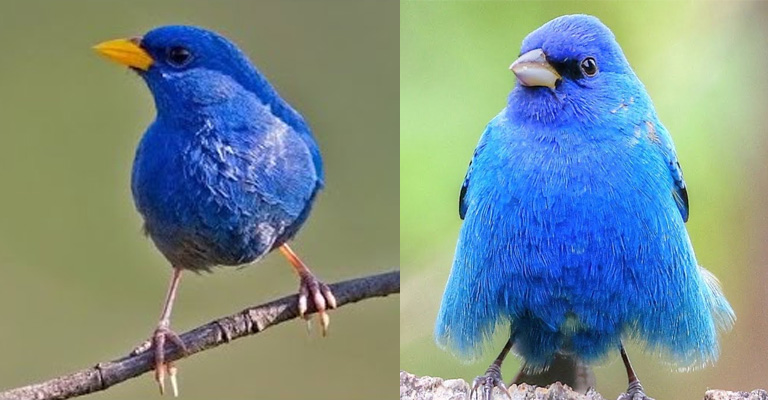
Blue Finch: the Vibrant Cardinalidae Member
Let’s first learn about these two birds so that you can understand their common criteria. However, let’s start with the Blue Finch. This cute creature simply holds the following criteria.
The Blue Finch’s Appearance
The Blue Finch showcases a striking appearance characterized by its vibrant blue plumage. The male Blue Finch boasts feathers ranging from deep cobalt blue to lighter shades, creating a captivating display.
One notable feature of the Blue Finch is its rusty wing bars, which add a touch of warmth to its overall appearance. These wing bars, along with its conical beak, contribute to its identification and distinguish it from other bird species.
Habitat and Range of the Blue Finch:
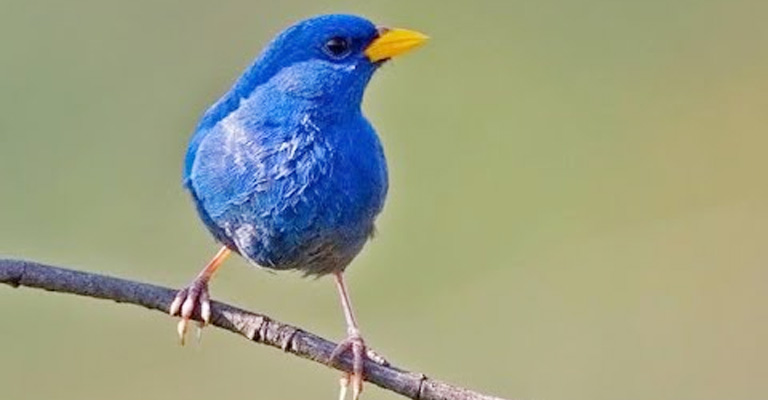
The Blue Finch primarily inhabits the central and eastern parts of the United States. It favors diverse habitats, including open woodlands, brushy areas, and shrublands.
These environments provide ample opportunities for the Blue Finch to find food, establish territories, and build nests. Their adaptability to various habitats contributes to their widespread distribution within their preferred range.
Interesting Facts and Trivia About the Blue Finch:
Breeding Behavior
During the breeding season, male Blue Finches engage in elaborate courtship displays, singing melodious songs and engaging in aerial displays to attract mates. Their vibrant plumage serves as a visual spectacle during these displays.
Nesting Habits
Blue Finches construct their nests in dense vegetation, such as shrubs and small trees. The female Blue Finch takes the lead in nest building, using twigs, grass, and other plant materials to create a secure and well-hidden nest.
Diet
Blue Finches have a diverse diet that includes seeds, insects, berries, and fruits. They forage on the ground or in shrubs, using their strong beaks to crack open seeds and extract food.
Migration Patterns
While some Blue Finches are year-round residents in certain regions, others undertake long-distance migrations to their breeding grounds, covering impressive distances to reach their preferred habitats.
The Blue Finch, with its vibrant blue plumage, rusty wing bars, and conical beak, is a remarkable member of the Cardinalidae family.
Its preference for the central and eastern parts of the United States, along with its adaptable nature, allows it to thrive in diverse habitats.
Understanding its appearance, habitat, and intriguing behaviors adds to the appreciation of this stunning avian species.
Indigo Bunting: the Small Gem of the Cardinalidae Family
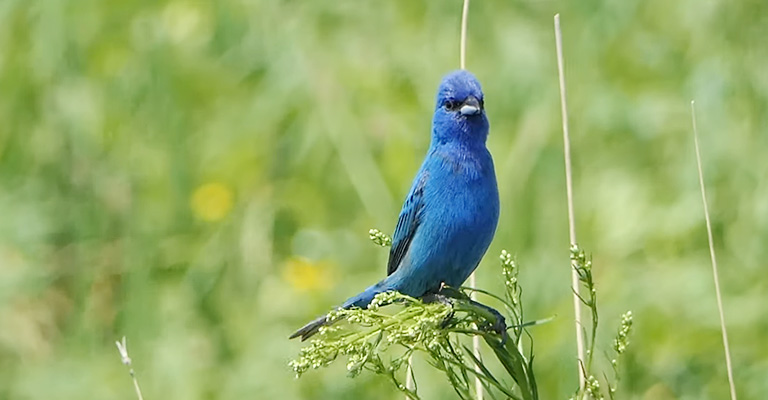
Now is the time to learn about the Indigo Bunting. This tiny bird possesses the following criteria.
The Indigo Bunting’s Appearance
The Indigo Bunting showcases a stunning appearance with its deep blue plumage that shimmers and reflects light. The male Indigo Bunting displays a vibrant indigo color, while the female has a more subdued brownish hue.
The plumage of the male intensifies during the breeding season, creating a mesmerizing sight. The Indigo Bunting also possesses a slender beak, which aids in its foraging activities.
Habitat and Range of the Indigo Bunting
The Indigo Bunting boasts a broad distribution across the eastern and central parts of the United States, as well as southern Canada. It can be found in a variety of habitats, including open fields, brushy areas, forest edges, and meadows.
The Indigo Bunting’s adaptability to different environments contributes to its extensive range and population.
Notable Characteristics and Behaviors of the Indigo Bunting
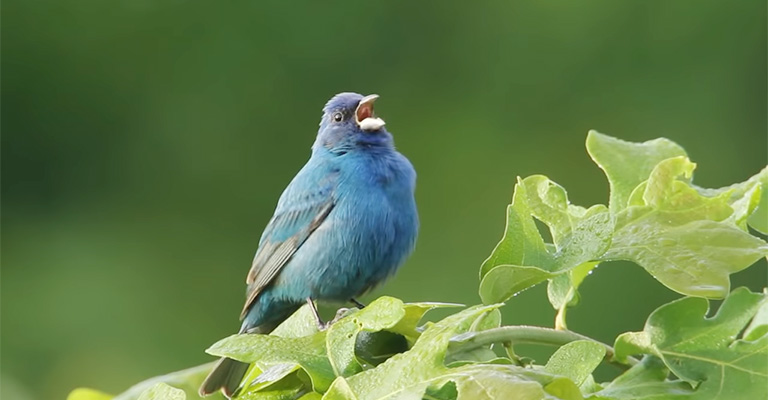
Song and Calls
The male Indigo Bunting is known for its distinctive song, which consists of a series of high-pitched, musical notes.
Its song is often described as sounding like “fire, fire, where, where, here, here, see it, see it.” These vocalizations are used for communication, territorial defense, and attracting mates.
Nesting Habits
Indigo Buntings construct cup-shaped nests made of grasses, leaves, and bark strips, typically placed in low vegetation or shrubs. The female Indigo Bunting takes the lead in nest building and incubating the eggs.
Migratory Patterns
Indigo Buntings undertake long-distance migrations, with some individuals traveling from their breeding grounds in North America to their wintering grounds in Central America or northern South America. These migrations cover significant distances and require precise navigation.
Behavior and Social Structure
Indigo Buntings are generally solitary birds, but they may form loose flocks during migration. They are also known to defend their territories vigorously, engaging in territorial displays and chasing away intruders.
The Indigo Bunting, with its intense, iridescent blue plumage and slender beak, is a small gem within the Cardinalidae family.
Its broader distribution across eastern and central parts of the United States and southern Canada allows for encounters with this captivating bird in various habitats.
Key Differences: Blue Finch Vs. Indigo Bunting
Let’s then check the key differences between Blue Fence and Indigo Bunting so that we can identify them easily.
Comparison of Physical Features
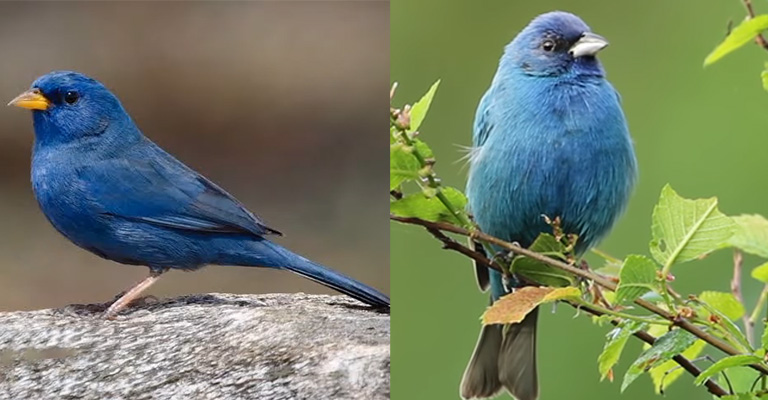
The Blue Finch and Indigo Bunting can be distinguished by several physical characteristics. Firstly, Blue Finches are slightly larger, measuring about 6.5 to 7 inches in length, while Indigo Buntings are smaller, typically measuring around 5 to 5.5 inches.
Secondly, Blue Finches possess rusty wing bars, which are absent in Indigo Buntings. Lastly, their beak shapes differ slightly, with Blue Finches having a thick, conical beak, and Indigo Buntings sporting a slender beak.
Highlighting the Distinction in Range and Habitat Preferences
The two species also exhibit differences in their range and habitat preferences. Blue Finches are primarily found in the central and eastern parts of the United States.
They favor habitats such as open woodlands, brushy areas, and shrublands. On the other hand, Indigo Buntings have a broader distribution, ranging across the eastern and central parts of the United States, as well as parts of southern Canada.
They inhabit diverse habitats including open fields, brushy areas, forest edges, and meadows.
Contrasting Songs and Calls of the Two Species
The songs and calls of Blue Finches and Indigo Buntings also differ, providing an auditory distinction between the two. Blue Finches have a melodious, warbling song consisting of a series of rich, musical notes.
In contrast, the male Indigo Bunting produces a distinctive song characterized by a series of high-pitched, musical notes. It is often described as sounding like “fire, fire, where, where, here, here, see it, see it.”
The songs and calls of each species play an important role in communication, territorial defense, and attracting mates.
The Blue Finch and Indigo Bunting can be differentiated by their physical features, range, and habitat preferences, as well as their songs and calls.
By understanding these key differences, bird enthusiasts can enhance their ability to identify and appreciate these unique avian species in their natural habitats.
Similarities and Confusion
Challenges in Differentiating These Birds
The similar blue plumage of the Blue Finch and Indigo Bunting poses a challenge in distinguishing between the two species, especially at a quick glance.
Both birds exhibit vibrant blue colors, which can make it difficult to identify them accurately without careful observation and attention to detail.
The Reasons Behind the Confusion
There are a few reasons behind the confusion between the Blue Finch and Indigo Bunting. Firstly, they share overlapping habitats, such as open woodlands and brushy areas, which increases the likelihood of encountering both species in the same areas.
Additionally, both birds belong to the Cardinalidae family, further contributing to the confusion. The Cardinalidae family includes other species like cardinals and New World buntings, which can add to the challenge of identifying specific species within the family.
How to Differentiate Blue Finch and Indigo Bunting
To differentiate between the Blue Finch and Indigo Bunting, careful observation and understanding of their distinct characteristics are essential. Here are a few tips:
- Pay attention to the presence or absence of rusty wing bars. Blue Finches have rusty wing bars, while Indigo Buntings lack them.
- Note the size difference between the two species. Blue Finches are slightly larger than Indigo Buntings.
- Observe the beak shape. Blue Finches have a thick, conical beak, while Indigo Buntings possess a slender beak.
- Take note of their songs and calls. Blue Finches have a melodious, warbling song, while Indigo Buntings produce a distinctive song with high-pitched, musical notes.
By carefully observing these distinguishing features and characteristics, birdwatchers can improve their ability to differentiate between the Blue Finch and Indigo Bunting, allowing for more accurate identification and appreciation of each species.
While the similarities between the Blue Finch and Indigo Bunting can lead to confusion, understanding their distinct characteristics and taking the time for careful observation can help resolve this confusion.
By applying these techniques, bird enthusiasts can confidently identify and enjoy these beautiful birds in their natural habitats.
Differences At A Glance: Blue Finch Vs. Indigo Bunting
| Difference | Blue Finch | Indigo Bunting |
| Size | Slightly larger (6.5-7 inches) | Smaller (5-5.5 inches) |
| Plumage | Vibrant blue with rusty wing bars | Intense, iridescent blue |
| Beak Shape | Thick, conical | Slender |
| Habitat Preference | Open woodlands, brushy areas, shrublands | Open fields, brushy areas, forest edges |
| Range | Central and eastern parts of the US | Eastern and central parts of the US, |
| southern Canada | ||
| Migration | Some migrate long distances | Some migrate to Central/South America |
| for winter | ||
| Song | Melodious warbling song | Distinctive high-pitched musical notes |
| Calls | Rich, musical notes | High-pitched, musical notes |
| Nesting Habit | Construct nests in dense vegetation | Nest in low vegetation or shrubs |
| Nest Building Responsibility | Both males and females participate | The female takes the lead in nest building |
| Breeding Behavior | Elaborate courtship displays | Courtship displays with singing and |
| aerial displays | ||
| Territory Defense | Vigorous territorial defense | Engages in territorial displays |
| Wingbars | Rusty wingbars present | Lack of rusty wing bars |
| Family | Cardinalidae | Cardinalidae |
| Preferred Food | Seeds, insects, berries, fruits | Seeds, insects, berries, fruits |
| Range of Distribution | Central and eastern parts of the US | Eastern and central parts of the US, |
| southern Canada | ||
| Preferred Habitat | Open woodlands, brushy areas, shrublands | Open fields, brushy areas, forest edges |
| Song and Calls | Melodious warbling song | Distinctive high-pitched musical notes |
FAQs
Blue Finch and Indigo Bunting are typically not commonly found in highly urbanized areas. They tend to prefer more natural habitats such as open woodlands, fields, and forest edges.
However, they may occasionally venture into suburban areas with suitable habitat conditions.
Yes, both Blue Finch and Indigo Bunting show sexual dimorphism, which means that males and females have different physical appearances. Males of both species display vibrant blue plumage, while females have a more subdued brownish coloration.
This difference helps with species identification.
Blue Finch and Indigo Bunting may overlap in terms of their migration patterns, but they do not migrate together as a single flock or group. Each species follows its own migratory route and timing, with some individuals covering long distances to reach their breeding or wintering grounds.
Hybridization between Blue Finch and Indigo Bunting is rare but has been documented in specific cases where their ranges overlap. However, such hybrid individuals are considered uncommon occurrences, as these species typically maintain their genetic and physical distinctiveness.
Blue Finch and Indigo Bunting populations are generally stable, and they are not considered globally threatened or endangered species. However, localized declines can occur due to habitat loss, pesticide use, and other factors.
Conservation efforts focused on preserving their habitats and addressing threats are crucial for their long-term survival.
End Call
The Blue Finch and Indigo Bunting may share a similar blue plumage, but they can be distinguished by size, plumage, beak shape, habitat preferences, range, songs, and calls.
Careful observation of these differences is crucial for accurate identification. Appreciating their unique traits enhances our understanding and admiration for these captivating members of the avian world.
Now, I think you can easily identify these two species. If you have problems identifying any other species, please let us know. We’ll try to guide you properly. Thank you for your time.
